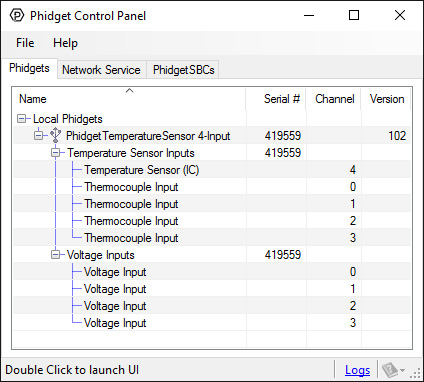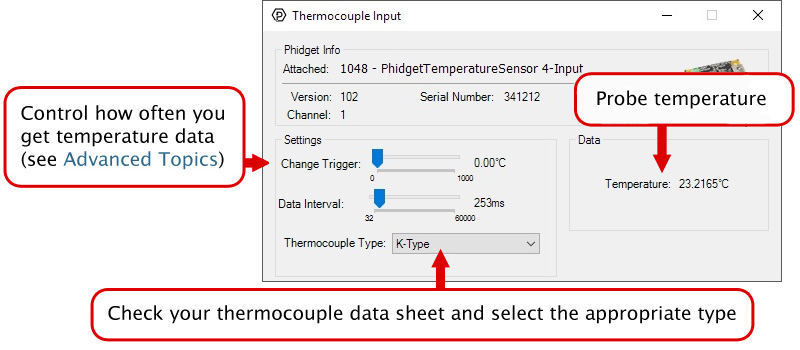1048 User Guide: Difference between revisions
No edit summary |
No edit summary |
||
| Line 10: | Line 10: | ||
</div> | </div> | ||
==Using | == Part 2: Using Your Phidget == | ||
===About=== | |||
The PhidgetTemperatureSensor with attached thermocouples allows you to measure extreme temperatures. This Phidget connects to a J, K, E, or T type thermocouple. Choose the thermocouple type in software and data will be converted to degrees Celsius automatically. If you have other thermocouple types, you can open the channel in VoltageInput mode and convert it to Celsius manually. | |||
===Explore Your Phidget Channels Using The Control Panel=== | |||
You can use your Control Panel to explore your Phidget's channels. | |||
'''1.''' Open your Control Panel, and you will find the following channels: | |||
[[Image:1048_Panel.jpg|link=|center]] | |||
== | '''2.''' Double click on a channel to open an example program. Each channel belongs to a different channel class: | ||
{{ | |||
{{UGC-Start}} | |||
{{UGC-Entry|Temperature Sensor (IC):| Measures the ambient temperature| | |||
In your Control Panel, double click on "Temperature Sensor (IC)": | |||
[[Image:1048-TemperatureSensorIC.jpg|center|link=]]}} | |||
{{UGC-Entry|Thermocouple Input:| Reports the probe temperature| | |||
In your Control Panel, double click on "Thermocouple Input": | |||
[[Image:1048-TemperatureSensorTC.jpg|center|link=]]}} | |||
{{UGC-Entry|Voltage Input:| Measures the raw probe voltage| | |||
In your Control Panel, double click on "Voltage Input": | |||
[[Image:1048-VoltageInput.jpg|center|link=]]}} | |||
{{UGC-End}} | |||
{{UG-Part3}} | |||
== Part 4: Advanced Topics and Troubleshooting == | |||
{{UGC-Start}} | |||
{{UGC-Addressing}} | |||
{{UGC-Graphing}} | |||
{{UGC-DataInterval}} | |||
{{UGC-Entry|Cold Junction Compensation and Self-heating|| | |||
Thermocouples consist of two junctions, one where the thermocouple meets the Phidget and one where the two wires are welded together at the sensing end of the device. In simplified terms, a thermocouple works by detecting the temperature difference between these two junctions. To measure the temperature at the sensing end we need to know the temperature where the thermocouple connects to the Phidget. There is an ambient temperature sensor on the board. The thermocouple reading is automatically calculated using the data from the on board temperature sensor. | |||
An important thing to note is that the ambient temperature sensor measures the temperature of the board and the air around it, though not specifically at the junction. Generally you can assume the two locations are nearly the same temperature, however as the electronics heat up by being powered on, there can be some small error introduced. This is exacerbated by having the board in an enclosed space where normal airflow is restricted thereby increasing the effect of self-heating. As a result we recommend that the board be left in as open and well ventilated/cooled a place as possible to minimize this error source. | |||
For more information on thermocouples, check out the [[Thermocouple Primer]]. | For more information on thermocouples, check out the [[Thermocouple Primer]]. | ||
}} | |||
{{ | {{UGC-End}} | ||
Revision as of 16:59, 16 March 2021
Part 1: Setup
Part 2: Using Your Phidget
About
The PhidgetTemperatureSensor with attached thermocouples allows you to measure extreme temperatures. This Phidget connects to a J, K, E, or T type thermocouple. Choose the thermocouple type in software and data will be converted to degrees Celsius automatically. If you have other thermocouple types, you can open the channel in VoltageInput mode and convert it to Celsius manually.
Explore Your Phidget Channels Using The Control Panel
You can use your Control Panel to explore your Phidget's channels.
1. Open your Control Panel, and you will find the following channels:

2. Double click on a channel to open an example program. Each channel belongs to a different channel class:
In your Control Panel, double click on "Temperature Sensor (IC)":

In your Control Panel, double click on "Thermocouple Input":

In your Control Panel, double click on "Voltage Input":

Part 3: Create your Program
Part 4: Advanced Topics and Troubleshooting
Before you open a Phidget channel in your program, you can set these properties to specify which channel to open. You can find this information through the Control Panel.
1. Open the Control Panel and double-click on the red map pin icon:

2. The Addressing Information window will open. Here you will find all the information you need to address your Phidget in your program.

See the Phidget22 API for your language to determine exact syntax for each property.
Note: Graphing and logging is currently only supported in the Windows version of the Phidget Control Panel.
In the Phidget Control Panel, open the channel for your device and click on the ![]() icon next to the data type that you want to plot. This will open up a new window:
icon next to the data type that you want to plot. This will open up a new window:

If you need more complex functionality such as logging multiple sensors to the same sheet or performing calculations on the data, you'll need to write your own program. Generally this will involve addressing the correct channel, opening it, and then creating an Event Handler and adding graphing/logging code to it.
The quickest way to get started is to download some sample code for your desired programming language and then search google for logging or plotting in that language (e.g. "how to log to csv in python") and add the code to the existing change handler.
Filtering
You can perform filtering on the raw data in order to reduce noise in your graph. For more information, see the Control Panel Graphing page.
Graph Type
You can perform a transform on the incoming data to get different graph types that may provide insights into your sensor data. For more information on how to use these graph types, see the Control Panel Graphing page.
The Change Trigger is the minimum change in the sensor data needed to trigger a new data event.
The Data Interval is the time (in ms) between data events sent out from your Phidget.
The Data Rate is the reciprocal of Data Interval (measured in Hz), and setting it will set the reciprocal value for Data Interval and vice-versa.
You can modify one or both of these values to achieve different data outputs. You can learn more about these properties here.
Thermocouples consist of two junctions, one where the thermocouple meets the Phidget and one where the two wires are welded together at the sensing end of the device. In simplified terms, a thermocouple works by detecting the temperature difference between these two junctions. To measure the temperature at the sensing end we need to know the temperature where the thermocouple connects to the Phidget. There is an ambient temperature sensor on the board. The thermocouple reading is automatically calculated using the data from the on board temperature sensor.
An important thing to note is that the ambient temperature sensor measures the temperature of the board and the air around it, though not specifically at the junction. Generally you can assume the two locations are nearly the same temperature, however as the electronics heat up by being powered on, there can be some small error introduced. This is exacerbated by having the board in an enclosed space where normal airflow is restricted thereby increasing the effect of self-heating. As a result we recommend that the board be left in as open and well ventilated/cooled a place as possible to minimize this error source.
For more information on thermocouples, check out the Thermocouple Primer.
